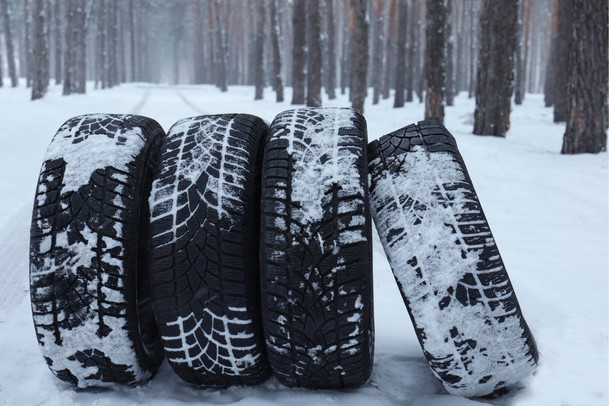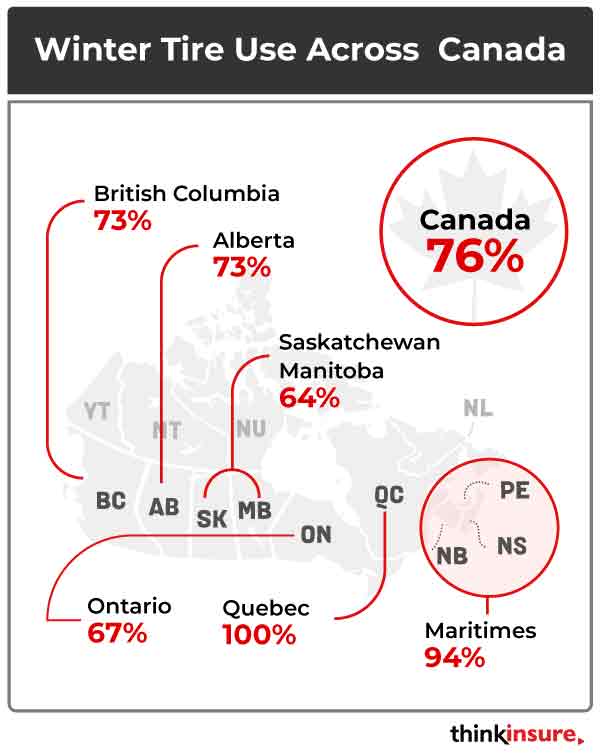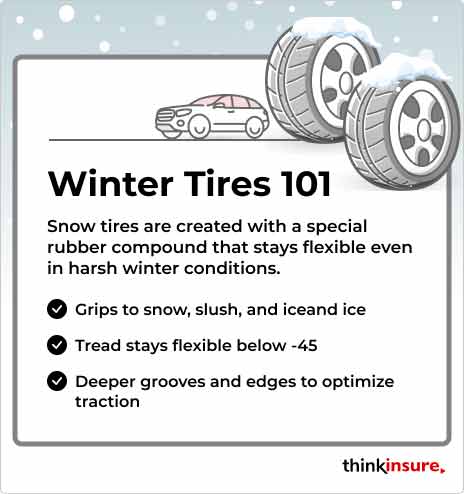
Written by Kayla Jane Barrie Updated on Nov 10, 2025 8 mins read

If you live in Canada, you know how important it is to drive safely in snowy and wet conditions. The data shows that more Canadians are swapping their tires for the season – As of 2020, over 70% of motorists now use snow tires. They are a crucial component of safe driving in winter.
Once the temperature falls below +7°C, rubber on all-season tires can stiffen up, creating less traction and braking more difficult. Winter tires improve your ability to stop, prevent sliding, and help you be a safer and more predictable driver because they are made of unique compounds to handle harsh winter conditions.
Looking to buy new snow tires? Or, first time buying winter tires? Use this guide to find the best winter tires for your vehicle.
Yes! When you install four winter tires, it can greatly improve your ability to drive in snow, frost, slush, and icy conditions – they create a safer winter driving experience. Advantages of installing snow tires in Canada include:
As soon as the cold weather begins to creep in and the threat of snow is imminent, it is time to start thinking about installing your snow tires. The use of winter tires in Canada is on the rise. A 2021 survey by the Tire and Rubber Association of Canada (TRAC) found that the numbers are up from 2017, when only 66% of Canadians had them installed.
Here is a regional breakdown of snow tire use in Canada for 2023:
The study also found that 79% of winter tire owners believe driving a vehicle equipped with winter tires has saved them from being involved in a potentially hazardous driving situation. 89% of Canadian drivers say they use them because they are protecting their families with the safety advantages.

It depends on how much winter driving you do. Most manufacturers say tires will last six years or more. If you drive more frequently, expect them to last about four years. Using winter tires in summer will cause them to wear much quicker.
Depending on how often you drive and what the winter road conditions are like, snow tires are expected to last an average of 20,000 to 30,000 kilometres.
Although many Canadians are embracing the benefits of them and lowering their car insurance quote, about 40% of drivers do not use snow tires. The survey identified several reasons why some drivers are resistant to using them:
You should be prepared to put on winter tires when temperatures hit 7°C or less. This means that you will install your winter tires near the beginning or middle of November in Ontario. Make sure you check your Ontario car insurance quote for any specific dates or details.
However, driving conditions and temperature will vary by region and from year to year. Check the forecast and book your appointment early or you could get stuck waiting to get them installed.

When buying winter tires, it is important to be diligent and purchase high-quality types. Therefore, it is important to shop based on price and the tire's rating and performance to ensure you get the traction you need for the driving you do.
Drivers are reminded to look for tires marked with the peaked mountain and snowflake logo. Tires that have the Three Peak Mountain Snowflake symbol (3PMSF) have been vigorously tested for use in severe snow and ice conditions. They are approved to have met or exceeded industry snow traction requirements.
Note that M+S means mud and snow for all-season - they may not have been officially tested as winter tires.
Are you shopping for the best winter tires in Canada? The top type for you will depend on the road conditions in your area. In general, brand names with a good reputation are the best option. They are proven commodities and will deliver the results you expect and trust on the road.
Here are some of the best-known and reputable brands to consider:
Once you have narrowed down your snow tire choices, looking at how they were tested and rated during tests is a good idea. Winter tires should be tested for dry and wet handling, ice and snow, comfort, and mileage. These tests are performed on closed tracks with unbiased experts. The tire rating will help you compare tires based on the weather conditions you will be driving in that will work best for your vehicle.
Before you invest in snow tires, you want to make sure they have been tested by field experts. It’s crucial for them to go under vigorous testing to examine how well they perform in wintery road conditions. Experts will also examine fuel consumption, road noise, and specific manufacturing traits such as the tread. Here are the top best rated snow tires for Canadians:
If you are searching for the top snow tires for your car, here is a look at the best options for the season:
When you pair trucks with their equal weight distribution and their four-wheel drive with winter tires, you can have big advantages during winter. Here are the top snow tires to consider for pickup truck drivers in Canada:
There is no easy answer to the best winter tires for your F150. You'll want to compare options depending on where you live, your driving habits and needs. Here are the top options for Canada’s favourite truck:
If you’ve invested in one of the best SUVs in Canada, it is highly recommended that you purchase snow tires to get through heavy snowfall, ice, and slushy roads.
Much like other products, drivers want to save money when buying winter tires. We all want affordable winter tires. Winter tire prices can vary greatly (starting as low as $120 per tire). If you are looking to invest in winter tires to have a safer drive this winter, here are some tips.
If you are looking to combine safety, and performance and stick to your budget, these are the top tires for winter.
When it comes to purchasing winter tires, you have lots of options. In addition to local tire shops in your city, here are some of the larger tire retailers to consider:
You can buy steel rims for winter tires in the same locations that sell winter tires, or check online marketplaces.
If you have not yet put on winter tires this year, it is not too late. Winter storms can have a habit of hitting when you least expect it. When you do put winter tires on your vehicle, remember these four basic tips:
Installing winter tires provides Ontario drivers with many benefits – safety, more control, and lower car insurance costs.
Winter tire costs vary widely. It depends on many factors such as the size of the tire, make and brand of the tire, date of purchase, and many other factors. You can get winter tires for as little as $50 per tire up to $300 or more per tire. Choose tires that are ideal for winter driving conditions in your area.
Only British Columbia and Quebec have made them mandatory by law during the winter months.
It is recommended to change winter tires to summer tires once the temperature is consistently above 7 degrees Celsius in your area.
Yes. Winter tires typically use more gas because of the increased grip and traction. Under-inflated tires also use more gas. Make sure your tires are properly inflated.
Depending on where you live, studded winter tires may not be permitted; you cannot use them in southern Ontario. There are no regulations in Alberta, Saskatchewan, Nunavut, Northwest Territories, and the Yukon. Check with your province to see if they are allowed.
Yes. Many Canadians change their own winter tires. If you know how to change a flat tire, you can change winter tires. You'll need a jack, lug wrench, and breaker bar.
No, winter tire designs and features can vary. They have different tread patterns, use different materials, and are available in a variety of sizes to suit the type of vehicle you drive.
Yes. Many online retailers and tire dealers sell winter tires online.
Installing winter tires will give you the peace of mind you deserve when handling winter weather conditions. Plus, you’ll qualify for a car insurance discount. Drive safe!
Read our insurance blog to get helpful tips, information and news.
Drive safe this winter! Check out these tips for driving in snowy and icy conditions in Ontario. Get other helpful info and FAQs on winter driving.
Drive safer this winter. Learn how the right set of winter tires drastically reduces stopping distance and risk on ice and snow. Get expert tips from your trusted insurance provider.
Ontario municipalities have until November 14 to remove all automated speed enforcement cameras following fast-tracked provincial legislation. This post breaks down why the government is removing them, the pushback from road safety advocates, and what alternative measures will replace them.
What is specified perils insurance coverage? Learn about named perils policies for Ontario drivers. Get info about coverage, if you need it & answers to common questions.